Efficient Tuning of the Third-Order Nonlinear Optical Properties of Some Functionalized Boron-Dipyrromethene Dyes
Abstract
1. Introduction
2. Experimental Section
2.1. Materials
2.2. UV-Vis-NIR Absorption Spectra
2.3. Measurements of the Nonlinear Optical (NLO) Properties
3. Results and Discussion
| BODIPY | λabsmax (nm) | Excitation | NLO Parameters | Reference |
|---|---|---|---|---|
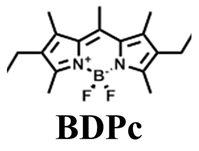 | 520 | 532 nm, 4 ns | β = −2.7 × 10−8 m/W Is = 4.1 MW/cm2 | [this work] |
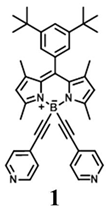 | 500 | 532 nm, 4 ns | β = −9.0 × 10−9 m/W γ′ = −5.1 × 10−16 m2/W χ(3) = 8 × 10−11 esu γ = 4.9 × 10−30 esu | [this work] |
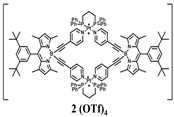 | 498 | 532 nm, 4 ns | β = −0.7 × 10−9 m/W γ′ = −1.2 × 10−16 m2/W χ(3) = 1.6 × 10−11 esu γ = 8.9 × 10−30 esu | [this work] |
 | 516 | 532 nm, 4 ns | β = −1.7 × 10−8 m/W Is = 6.3 MW/cm2 | [this work] |
 | 517 | 532 nm, 4 ns | β = −1.7 × 10−8 m/W Is = 5.1 MW/cm2 | [this work] |
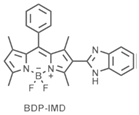 | 515 | 532 nm, 5 ns | β = −0.7 × 10−11 m/W γ′ = 9.5 × 10−19 m2/W χ(3) = 3.8 × 10−13 esu | [42] |
 | 527 | 532 nm, 5 ns | β = −2.7 × 10−11 m/W γ′ = 4.9 × 10−19 m2/W χ(3) = 12.2 × 10−13 esu | [43] |
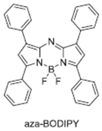 | 663 | 532 nm, 3 ns | β = 3.1 × 10−10 m/W | [44] |
 | 663 | 532 nm, 10 ns | β = 2.2 × 10−9 m/W γ = 9.8 × 10−30 esu | [45] |
 | 640 | 532 nm, 4 ns | β = 2.0 × 10−10 m/W γ′ = 1.7 × 10−15 m2/W | [46] |
 | 532 | 532 nm, 5 ns | β = −4.7 × 10−12 m/W γ′ = 2.3 × 10−19 m2/W χ(3) = 1.1 × 10−12 esu | [47] |
4. Conclusions
Author Contributions
Funding
Data Availability Statement
Acknowledgments
Conflicts of Interest
References
- Ulrich, G.; Ziessel, R.; Harriman, A. The chemistry of fluorescent bodipy dyes: Versatility unsurpassed. Angew. Chem. Int. Ed. 2008, 47, 1184–1201. [Google Scholar] [CrossRef]
- Boens, N.; Leen, V.; Dehaen, W. Fluorescent indicators based on BODIPY. Chem. Soc. Rev. 2012, 41, 1130–1172. [Google Scholar] [CrossRef]
- Loudet, A.; Burgess, K. BODIPY dyes and their derivatives: Syntheses and spectroscopic properties. Chem. Rev. 2007, 107, 4891–4932. [Google Scholar] [CrossRef] [PubMed]
- Liu, S.; Shi, Z.; Xu, W.; Yang, H.; Xi, N.; Liu, X.; Zhao, Q.; Huang, W. A class of wavelength-tunable near-infrared aza-BODIPY dyes and their application for sensing mercury ion. Dye. Pigment. 2014, 103, 145–153. [Google Scholar] [CrossRef]
- Pereira, N.A.M.; Pinho e Melo, T.M.V.D. Recent Developments in the Synthesis of Dipyrromethanes. A Review. Org. Prep. Proced. Int. 2014, 46, 183–213. [Google Scholar] [CrossRef]
- Singh-Rachford, T.N.; Haefele, A.; Ziessel, R.; Castellano, F.N. Boron Dipyrromethene Chromophores: Next Generation Triplet Acceptors/Annihilators for Low Power Upconversion Schemes. J. Am. Chem. Soc. 2008, 130, 16164–16165. [Google Scholar] [CrossRef]
- Benstead, M.; Mehl, G.H.; Boyle, R.W. 4,4-Difluoro-4-bora-3a,4a-diaza-s-indacenes (BODIPYs) as components of novel light active materials. Tetrahedron 2011, 67, 3573–3601. [Google Scholar] [CrossRef]
- Li, F.; Yang, S.I.; Ciringh, Y.; Seth, J.; Martin, C.H., II; Singh, D.L.; Kim, D.; Birge, R.R.; Bocian, D.F.; Holten, D.; et al. Design, synthesis, and photodynamics of light-harvesting arrays comprised of a porphyrin and one, two, or eight boron-dipyrrin accessory pigments. J. Am. Chem. Soc. 1998, 120, 10001–10017. [Google Scholar] [CrossRef]
- Khan, T.K.; Broring, M.; Mathur, S.; Ravikanth, M. Boron dipyrrin-porphyrin conjugates. Coord. Chem. Rev. 2013, 257, 2348–2387. [Google Scholar] [CrossRef]
- Diring, S.; Puntoriero, F.; Nastasi, F.; Campagna, S.; Ziessel, R. Star-Shaped Multichromophoric Arrays from Bodipy Dyes Grafted on Truxene Core. J. Am. Chem. Soc. 2009, 131, 6108–6110. [Google Scholar] [CrossRef] [PubMed]
- Ojida, A.; Sakamoto, T.; Inoue, M.-A.; Fujishima, S.-H.; Lippens, G.; Hamachi, I. Fluorescent BODIPY-based Zn(II) complex as a molecular probe for selective detection of neurofibrillary tangles in the brains of Alzheimer’s disease patients. J. Am. Chem. Soc. 2009, 131, 6543–6548. [Google Scholar] [CrossRef] [PubMed]
- Kamkaew, A.; Lim, S.H.; Lee, H.B.; Kiew, L.V.; Chung, L.Y.; Burgess, K. BODIPY dyes in photodynamic therapy. Chem. Soc. Rev. 2013, 42, 77–88. [Google Scholar] [CrossRef]
- Gabe, Y.; Urano, Y.; Kikuchi, K.; Kojima, H.; Nagano, T. Highly sensitive fluorescence probes for nitric oxide based on boron dipyrromethene chromophores rational design of potentially useful bioimaging fluorescence probe. J. Am. Chem. Soc. 2004, 126, 3357–3367. [Google Scholar] [CrossRef] [PubMed]
- Bessette, A.; Hanan, G.S. Design, synthesis and photophysical studies of dipyrromethene-based materials: Insights into their applications in organic photovoltaic devices. Chem. Soc. Rev. 2014, 43, 3342–3405. [Google Scholar] [CrossRef]
- Khan, T.K.; Sheokand, P.; Agarwal, N. Synthesis and studies of aza-BODIPY-based π-conjugates for organic electronic applications. Eur. J. Org. Chem. 2013, 2014, 1416–1422. [Google Scholar] [CrossRef]
- Duran-Sampedro, G.; Agarrabeitia, A.R.; Garcia-Moreno, I.; Costela, A.; Bañuelos, J.; Arbeloa, T.; López Arbeloa, I.; Chiara, J.L.; Ortiz, M.J. Chlorinated BODIPYs: Surprisingly efficient and highly photostable laser dyes. Eur. J. Org. Chem. 2012, 22, 6335–6350. [Google Scholar] [CrossRef]
- Torre, G.; Vázquez, P.; Agulló-López, F.; Torres, T. Role of structural factors in the nonlinear optical properties of phthalocyanines and related compounds. Chem. Rev. 2004, 104, 3723–3750. [Google Scholar] [CrossRef]
- Yesodha, S.K.; Pillai, C.K.S.; Tsutsumi, N. Stable polymeric materials for nonlinear optics: A review based on azobenzene systems. Prog. Polym. Sci. 2004, 29, 45–74. [Google Scholar] [CrossRef]
- Garreau-de Bonneval, B.; Ching, K.I.M.-C.; Alary, F.; Bui, T.-T.; Valade, L. Neutral d8 metal bis-dithiolene complexes: Synthesis, electronic properties and applications. Coord. Chem. Rev. 2010, 254, 1457–1467. [Google Scholar] [CrossRef]
- Liu, X.; Zhang, J.; Li, K.; Sun, X.; Wu, Z.; Ren, A.; Feng, J. New insights into two-photon absorption properties of functionalized aza-BODIPY dyes at telecommunication wavelengths: A theoretical study. Phys. Chem. Chem. Phys. 2013, 15, 4666–4676. [Google Scholar] [CrossRef] [PubMed]
- Tekin, S.; Küçüköz, B.; Yilmaz, H.; Savinç, G.; Hayvali, M.; Yaglioglu, H.G.; Elmali, A. Enhancement of two photon absorption properties by charge transfer innewly synthesized aza-boron-dipyrromethene compounds containing triphenylamine, 4-ethynyl-N,N-dimethylaniline and methoxy moieties. J. Photochem. Photobiol. A 2013, 256, 23–28. [Google Scholar] [CrossRef]
- Shi, W.-J.; Lo, P.-C.; Singh, A.; Ledoux-Rak, I.; Ng, D.K.P. Synthesis and second-order nonlinear optical properties of push-pull BODIPY derivatives. Tetrahedron 2012, 68, 8712–8718. [Google Scholar] [CrossRef]
- Zheng, Q.; He, G.S.; Prasad, P.N. A novel near IR two-photon absorbing chromophore: Optical limiting and stabilization performances at an optical communication wavelength. Chem. Phys. Lett. 2009, 475, 250–255. [Google Scholar] [CrossRef]
- Adarsh, N.; Avirah, R.R.; Ramaiah, D. Tuning photosensitized singlet oxygen generation efficiency of novel aza-BODIPY dyes. Org. Lett. 2010, 12, 5720–5723. [Google Scholar] [CrossRef]
- Küçüköz, B.; Hayvali, M.; Yilmaz, H.; Uğuz, B.; Kürüm, U.; Yaglioglu, H.G.; Elmali, A. Synthesis, optical properties and ultrafast dynamics of aza-boron-dipyrromethene compounds containing methoxy and hydroxy groups and two-photon absorption cross-section. J. Photochem. Photobiol. A 2012, 247, 24–29. [Google Scholar] [CrossRef]
- Xenogiannopoulou, E.; Medved, M.; Iliopoulos, K.; Couris, S.; Papadopoulos, M.G.; Bonifazi, D.; Sooambar, C.; Mateo-Alonso, A.; Prato, M. Nonlinear optical properties of ferrocene- and porphyrin-[60]fullerene dyads. Chem. Phys. Chem. 2007, 8, 1056–1064. [Google Scholar] [CrossRef] [PubMed]
- Imahori, H.; Sekiguchi, Y.; Kashiwagi, Y.; Sato, T.; Araki, Y.; Ito, O.; Yamada, H.; Fukuzumi, S. Long-lived charge-separated state generated in a ferrocene-meso,meso-linked porphyrin trimer-fullerene pentad with high quantum-yield. Chem. Eur. J. 2004, 10, 3184–3196. [Google Scholar] [CrossRef]
- Schuster, D.I.; Li, K.; Guldi, D.M.; Palkar, A.; Echegoyen, L.; Stanisky, C.; Cross, R.J.; Niemi, M.; Tkachenko, N.V.; Lemmetyinen, H. Azobenzene-linked porphyrin-fullerene dyads. J. Am. Chem. Soc. 2007, 129, 15973–15982. [Google Scholar] [CrossRef]
- Kaloudi-Chantzea, A.; Karakostas, N.; Raptopoulou, C.P.; Psycharis, V.; Saridakis, E.; Griebel, J.; Hermann, R.; Pistolis, G. Coordination-Driven Self Assembly of a Brilliantly Fluorescent Rhomboid Cavitand Composed of Bodipy-Dye Subunits. J. Am. Chem. Soc. 2010, 132, 16327–16329. [Google Scholar] [CrossRef]
- Kaloudi-Chantzea, A.; Karakostas, N.; Pitterl, F.; Raptopoulou, C.P.; Glezos, N.; Pistolis, G. Efficient Supramolecular Synthesis of a Robust Circular Light—Harvesting Bodipy-dye Based Array. Chem. Commun. 2012, 48, 12213–12215. [Google Scholar] [CrossRef]
- Kaloudi-Chantzea, A.; Martinou, E.; Seintis, K.; Karakostas, N.; Giastas, P.; Pitterl, F.; Oberacher, H.; Fakisb, M.; Pistolis, G. Formation of a highly—Ordered Rigid Multichromophoric 3D Supramolecular Network by Combining Ionic and Coordination—Driven Self—Assembly. Chem. Commun. 2016, 52, 3388–3391. [Google Scholar] [CrossRef]
- Aloukos, P.; Chatzikyriakos, G.; Papagiannouli, I.; Liaros, N.; Couris, S. Transient nonlinear optical response of some symmetrical nickel dithiolene complexes. Chem. Phys. Lett. 2010, 495, 245–250. [Google Scholar] [CrossRef]
- Boyd, R.W. Nonlinear Optics; Academic Press: Cambridge, MA, USA, 1992; ISBN 9780128110034. [Google Scholar]
- Sharma, K.K.; Rao, K.D.; Kumar, G.R. Nonlinear optical interactions in dye-doped solids. Opt. Quantum Electron. 1994, 26, 1–23. [Google Scholar] [CrossRef]
- Brédas, J.L.; Adant, C.; Tackx, P.; Persoons, A. Third-order nonlinear optical response in organic materials: Theoretical and experimental aspects. Chem. Rev. 1994, 94, 243–278. [Google Scholar] [CrossRef]
- Porrès, L.; Mongin, O.; Blanchard-Desce, M. Synthesis, fluorescence and two-photon absorption properties of multichromophoric boron-dipyrromethene fluorophores for two-photon-excited fluorescence applications. Tetrahedron Lett. 2006, 47, 1913–1917. [Google Scholar] [CrossRef][Green Version]
- Zhao, Z.; Chen, B.; Geng, J.; Chang, Z.; Aparicio-Ixta, L.; Nie, H.; Chin Goh, C.; Guan Ng, L.; Qin, A.; Ramos-Ortiz, G.; et al. Red Emissive Biocompatible Nanoparticles from Tetraphenylethene-Decorated BODIPY Luminogens for Two-Photon Excited Fluorescence Cellular Imaging and Mouse Brain Blood Vascular Visualization. Part. Part. Syst. Charact. 2014, 31, 481–491. [Google Scholar] [CrossRef]
- Li, L.-L.; Li, K.; Li, M.-Y.; Shi, L.; Liu, Y.-H.; Zhang, H.; Pan, S.-L.; Wang, N.; Zhou, Q.; Yu, X.-Q. BODIPY-Based Two-Photon Fluorescent Probe for Real-Time Monitoring of Lysosomal Viscosity with Fluorescence Lifetime Imaging Microscopy. Anal. Chem. 2018, 90, 5873–5878. [Google Scholar] [CrossRef]
- Ren, C.; Deng, X.; Hu, W.; Li, J.; Miao, X.; Xiao, S.; Liu, H.; Fan, Q.; Wang, K.; He, T. A near-infrared I emissive dye: Toward the application of saturable absorber and multiphoton fluorescence microscopy in the deep-tissue imaging window. Chem. Commun. 2019, 55, 5111–5114. [Google Scholar] [CrossRef]
- Sevinc, G.; Kucukoz, B.; Elmali, A.; Hayvali, M. The synthesis of -1, -3, -5, -7, -8 aryl substituted borondipyrromethene chromophores:Nonlinear optical and photophysical characterization. J. Mol. Struct. 2020, 1206, 127691. [Google Scholar] [CrossRef]
- Aloukos, P.; Orfanos, I.; Dalamaras, I.; Kaloudi-Chantzea, A.; Avramopoulos, A.; Pistolis, G.; Couris, S. Nonlinear optical response of some Boron-dipyrromethene dyes: An experimental and theoretical investigation. Mater. Chem. Phys. 2022, 283, 126057. [Google Scholar] [CrossRef]
- Thakare, S.S.; Screenath, M.C.; Chitrambalam, S.; Joe, I.S.; Sekar, N. Non-linear optical study of BODIPY-benzimidazole conjugate by solvatochromic, Z-scan and theoretical methods. Opt. Mater. 2017, 64, 453–460. [Google Scholar] [CrossRef]
- Mallah, R.R.; Mohbiya, D.R.; Screenath, M.C.; Chitrambalam, S.; Joe, I.S.; Sekar, N. NLOphoric benzyl substituted BODIPY and BOPHY: A comprehensive linear and nonlinear optical study by spectroscopic, DFT and Z-scan measurement. Spectrochim. Acta Part A Mol. Biomol. Spectrosc. 2019, 215, 122–129. [Google Scholar] [CrossRef]
- Frenette, M.; Hatamimoslehabadi, M.; Bellinger-Buckley, S.; Laoui, S.; Bag, S.; Dantiste, O.; Rochford, J.; Yelleswarapu, C. Nonlinear optical properties of multipyrolle dyes. Chem. Phys. Lett. 2014, 608, 303–307. [Google Scholar] [CrossRef]
- Ngoy, B.P.; May, A.K.; Mack, J.; Nyokong, T. Effect of bromination on the optical limiting properties at 532 nm of BODIPY dyes with p-benzyloxystyryl groups at the 3,5-positions. J. Mol. Struct. 2019, 1175, 745–753. [Google Scholar] [CrossRef]
- Zhu, M.; Jiang, L.; Yuan, M.; Liu, X.; Ouyang, C.; Zheng, H.; Yin, X.; Zuo, Z.; Liu, H.; Li, Y. Efficient Tuning Nonlinear Optical Properties: Synthesis and Characterization of a Series of Novel Poly(aryleneethynylene)s Co-Containing BODIPY. J. Polym. Sci. Pol. Chem. 2008, 46, 7401–7410. [Google Scholar] [CrossRef]
- Mallah, R.R.; Mohbiya, D.R.; Screenath, M.C.; Chitrambalam, S.; Joe, I.S.; Sekar, N. Non-linear optical response of meso substituted dipyrromethene boron difluoride dyes: Synthesis, photophysical, DFT and Z scan study. Opt. Mater. 2019, 89, 164–172. [Google Scholar] [CrossRef]
- Divyasree, M.C.; Shiju, E.; Dijo, P.; Chandrasekharan, K. ZnSe-BODIPY hybrid system for nonlinear optical switching applications. Mater. Chem. Phys. 2019, 232, 311–318. [Google Scholar] [CrossRef]
- Kulyk, B.; Taboukhat, S.; Akdas-Kilig, H.; Fillaut, J.-L.; Boughalebb, Y.; Sahraoui, B. Nonlinear refraction and absorption activity of dimethylaminostyryl substituted BODIPY dyes. RSC Adv. 2016, 88, 84854–84859. [Google Scholar] [CrossRef]
- Kulyk, B.; Taboukhat, S.; Akdas-Kilig, H.; Fillaut, J.-L.; Boughalebb, Y.; Sahraoui, B. Tuning the nonlinear optical properties of BODIPYs by functionalization with dimethylaminostyryl substituents. Dye. Pigment. 2017, 137, 507–511. [Google Scholar] [CrossRef]
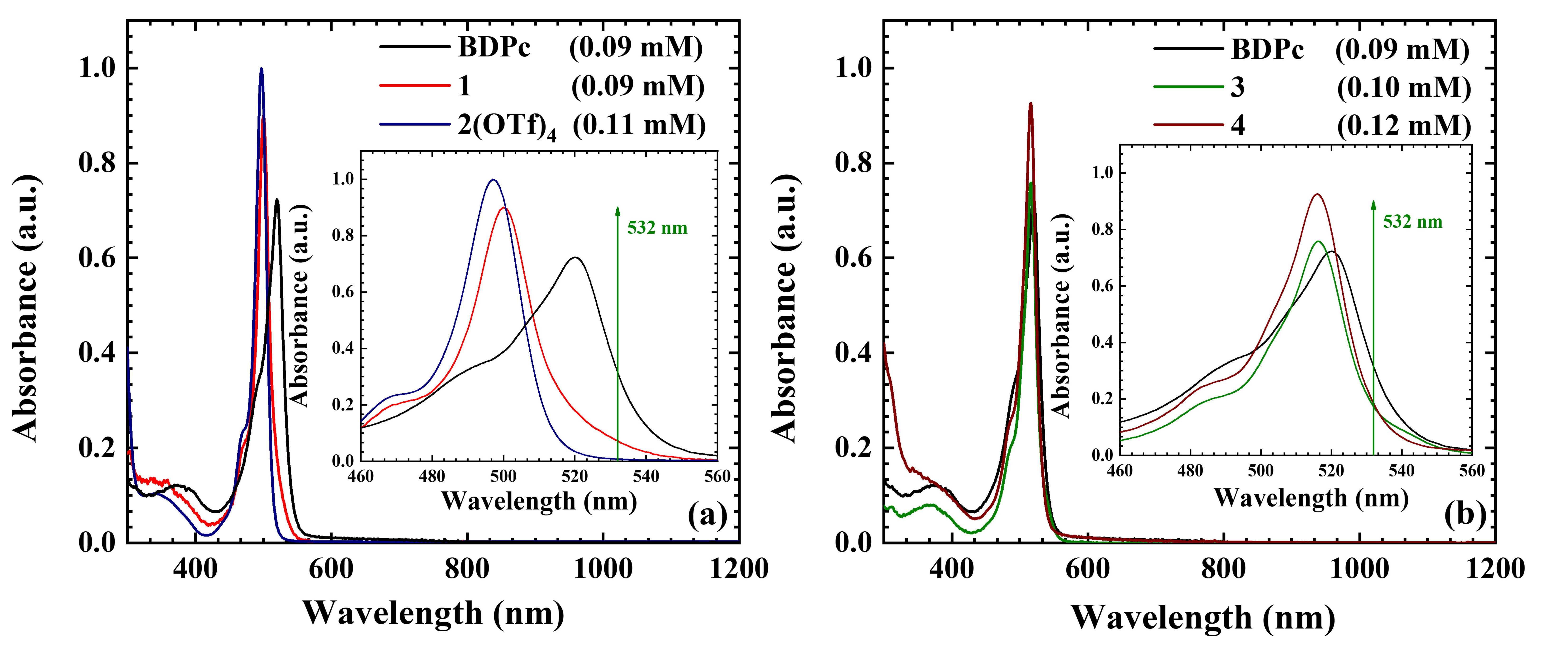
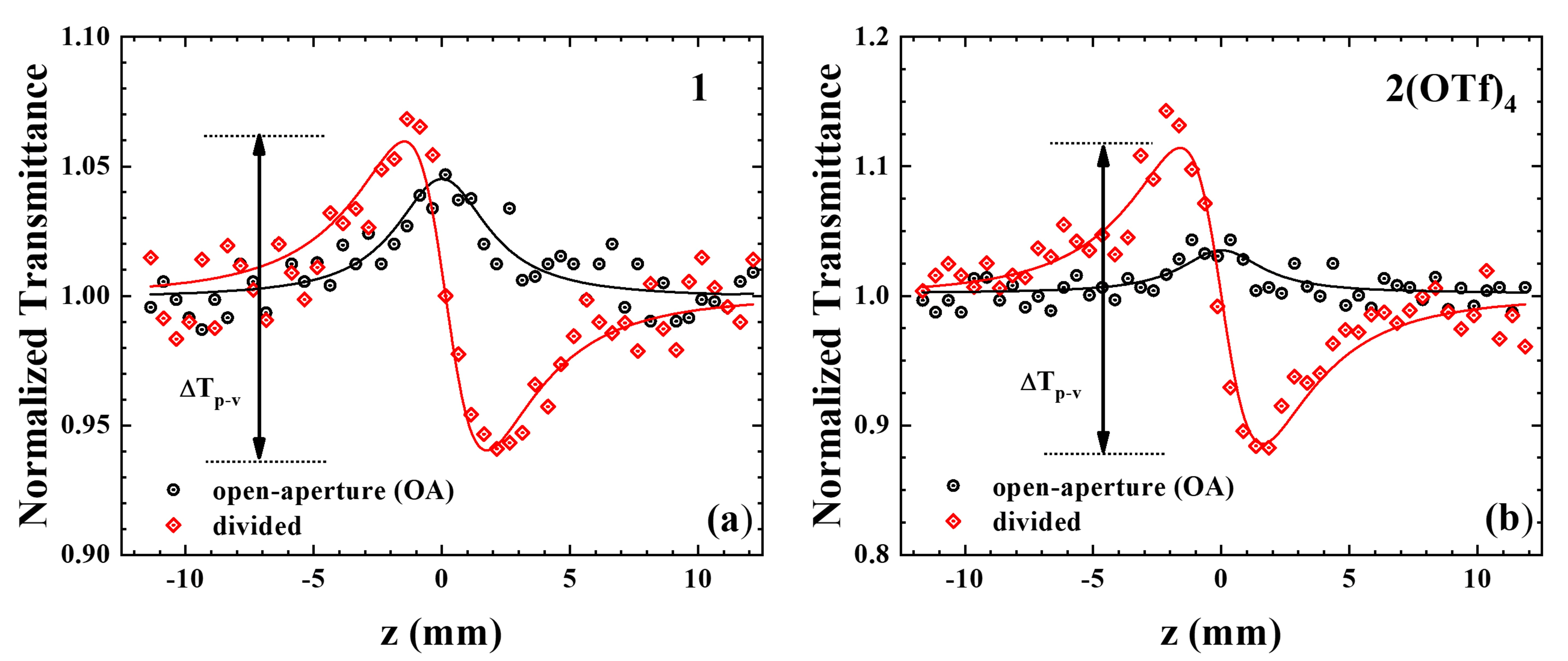
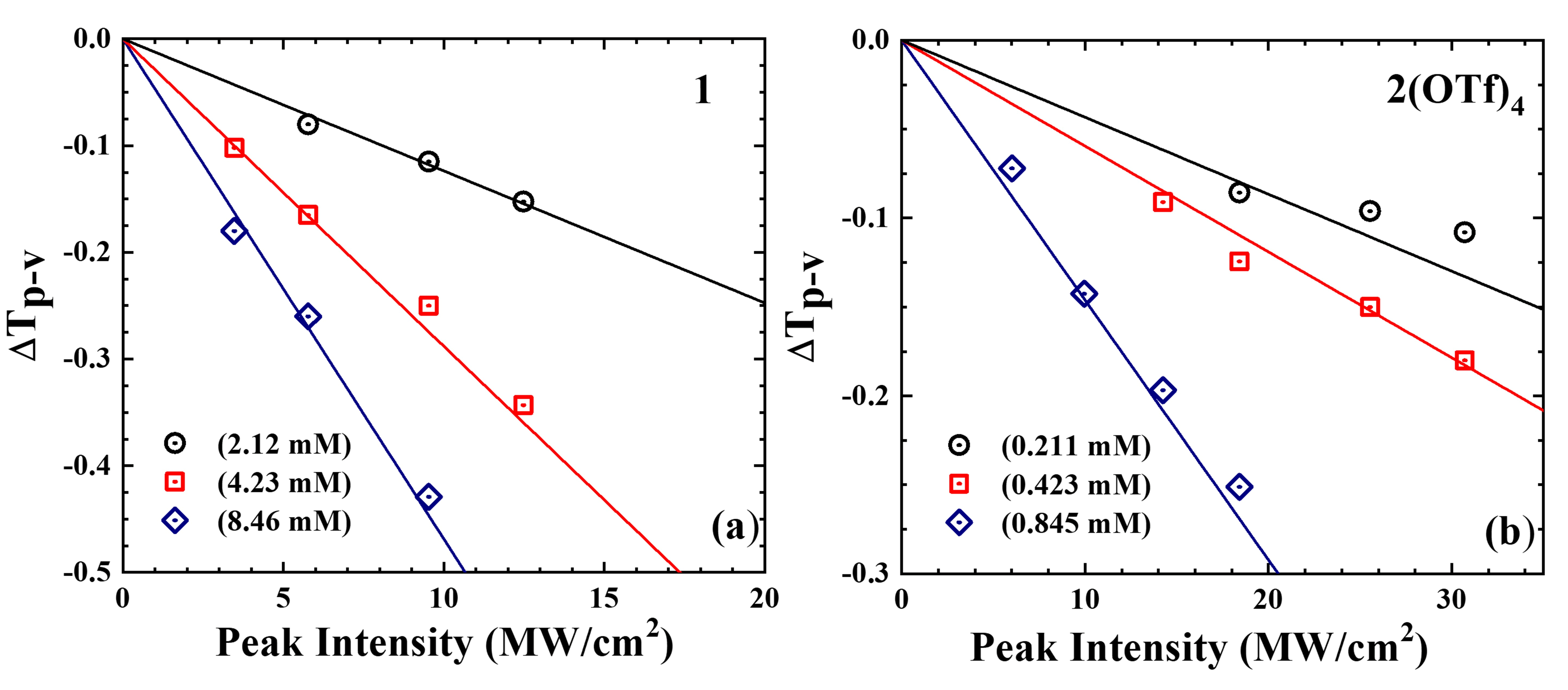

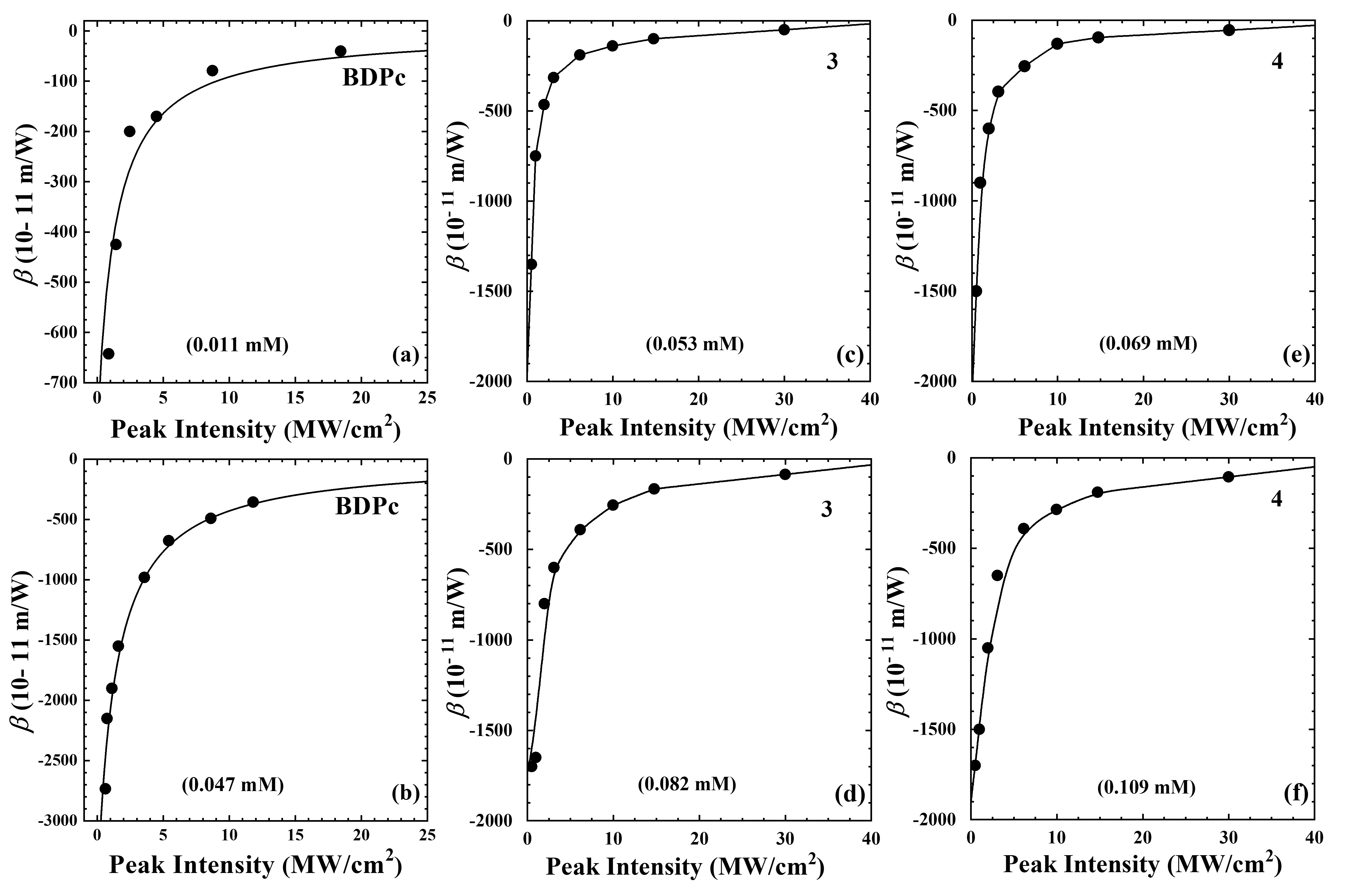
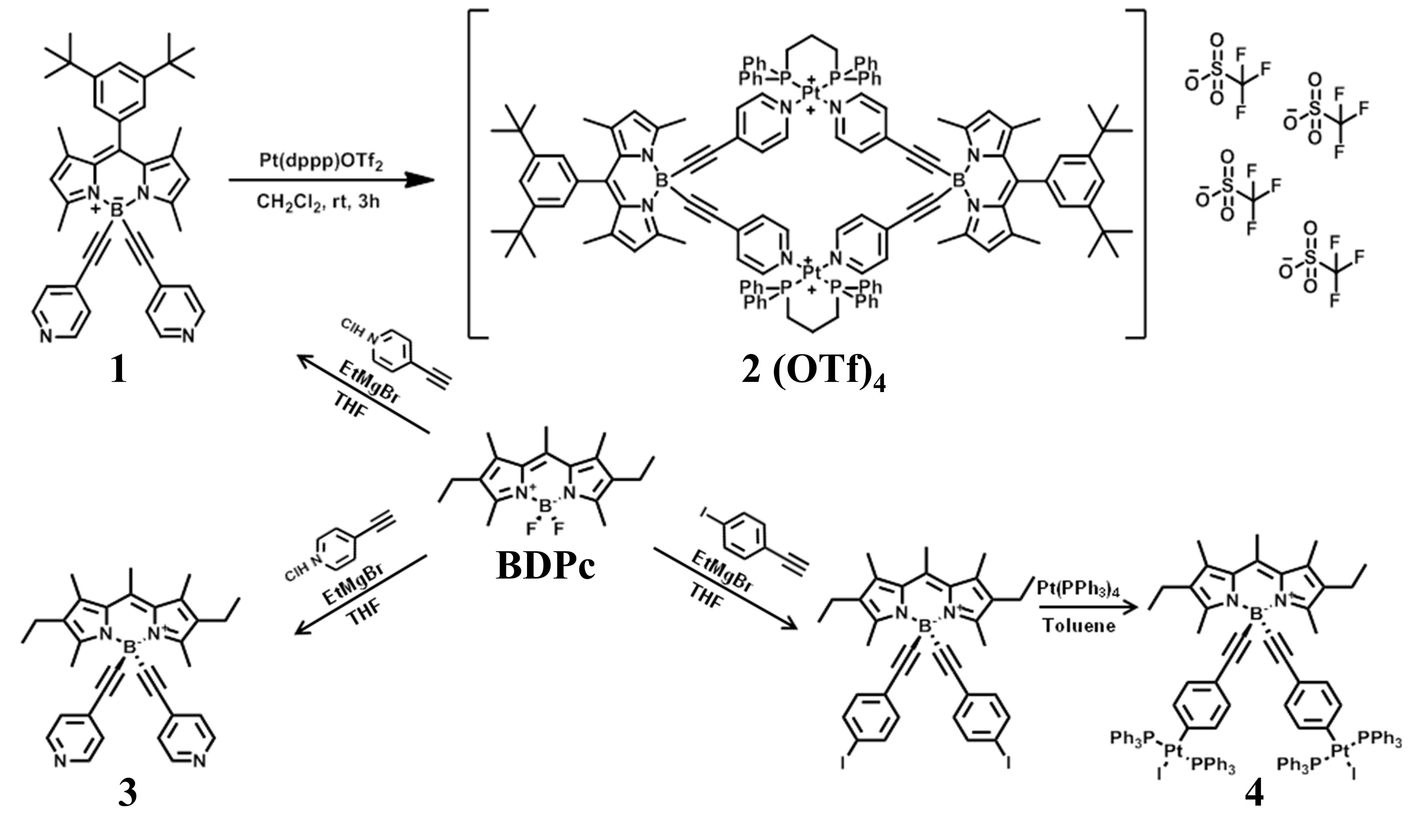
| BODIPY | MW | α0/c (cm−1/mM) | λabsmax (nm) | εmax (mol−1 L cm−1) | Φf | λflmax (nm) | kf (×108 s−1) | τ (ns) |
|---|---|---|---|---|---|---|---|---|
| BDPc | 318.21 | 107 | 520 | 78,200 | 0.88 | 538 | 1.44 | 6.10 |
| 1 | 602.62 | 0.64 | 500 | 94,160 | 0.93 | 508 | 1.83 | 5.06 |
| 2(OTf)4 | 3016.55 | 0.17 | 498 | 94,160 | 0.95 | 508 | 1.59 | 5.94 |
| 3 | 484.44 | 60 | 516 | 78,400 | 0.83 | 534 | 1.38 | 5.98 |
| 4 | 2173.56 | 59 | 517 | 77,300 | 0.86 | 534 | 1.24 | 6.91 |
| BODIPY | c (mM) | β (×10−9 m/W) | γ′ (×10−16 m2/W) | Imχ(3) (×10−11 esu) | Reχ(3) (×10−11 esu) | χ(3) (×10−11 esu) | χ(3)/c (×10−11 esu/mM) | γ (×10−30 esu) |
|---|---|---|---|---|---|---|---|---|
| 1 | 8.46 | −9.0 | −5.1 | −5.0 | −6.6 | 8.0 | 1.0 ± 0.1 | 4.9 ± 0.3 |
| 4.23 | −4.4 | −2.9 | −2.3 | −3.7 | 4.4 | |||
| 2.12 | −2.0 | −1.6 | −1.0 | −2.1 | 2.0 | |||
| 2(OTf)4 | 0.845 | −0.7 | −1.2 | −0.4 | −1.5 | 1.6 | 1.9 ± 0.3 | 8.9 ± 0.8 |
| 0.423 | −0.5 | −0.4 | −0.3 | −0.5 | 0.6 | |||
| 0.211 | −0.3 | −0.3 | −0.2 | −0.4 | 0.5 |
Disclaimer/Publisher’s Note: The statements, opinions and data contained in all publications are solely those of the individual author(s) and contributor(s) and not of MDPI and/or the editor(s). MDPI and/or the editor(s) disclaim responsibility for any injury to people or property resulting from any ideas, methods, instructions or products referred to in the content. |
© 2025 by the authors. Licensee MDPI, Basel, Switzerland. This article is an open access article distributed under the terms and conditions of the Creative Commons Attribution (CC BY) license (https://creativecommons.org/licenses/by/4.0/).
Share and Cite
Orfanos, I.; Aloukos, P.; Kaloudi-Chantzea, A.; Pistolis, G.; Couris, S. Efficient Tuning of the Third-Order Nonlinear Optical Properties of Some Functionalized Boron-Dipyrromethene Dyes. Nanomaterials 2025, 15, 1549. https://doi.org/10.3390/nano15201549
Orfanos I, Aloukos P, Kaloudi-Chantzea A, Pistolis G, Couris S. Efficient Tuning of the Third-Order Nonlinear Optical Properties of Some Functionalized Boron-Dipyrromethene Dyes. Nanomaterials. 2025; 15(20):1549. https://doi.org/10.3390/nano15201549
Chicago/Turabian StyleOrfanos, Ioannis, Panagiotis Aloukos, Antonia Kaloudi-Chantzea, George Pistolis, and Stelios Couris. 2025. "Efficient Tuning of the Third-Order Nonlinear Optical Properties of Some Functionalized Boron-Dipyrromethene Dyes" Nanomaterials 15, no. 20: 1549. https://doi.org/10.3390/nano15201549
APA StyleOrfanos, I., Aloukos, P., Kaloudi-Chantzea, A., Pistolis, G., & Couris, S. (2025). Efficient Tuning of the Third-Order Nonlinear Optical Properties of Some Functionalized Boron-Dipyrromethene Dyes. Nanomaterials, 15(20), 1549. https://doi.org/10.3390/nano15201549







